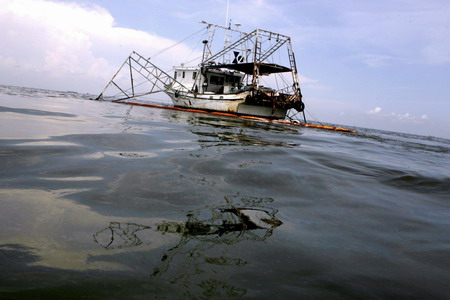Asia-Pacific
Battle to contain oil spill may linger into fall
(Agencies)
Updated: 2010-06-07 09:45
 |
Large Medium Small |
|
 A shrimp boat skims oil in Bartaria Bay near Venice, Louisiana June 6, 2010. [Agencies] |
NEW ORLEANS -- A special cap is capturing more and more of the crude pouring from a damaged well in the Gulf of Mexico, but that bit of hope was tempered Sunday by a sharp dose of pragmatism as the federal government's point man warned the crisis could stretch into the fall.
| ||||
Instead, he warned on CBS' "Face the Nation" that the battle to contain the oil is likely to stretch into the fall. The cap will trap only so much of the oil, and relief wells being drilled won't be completed until August. In the meantime, oil will continue to spew out.
"But even after that, there will be oil out there for months to come," Allen said.
"This will be well into the fall. This is a siege across the entire Gulf. This spill is holding everybody hostage, not only economically but physically. And it has to be attacked on all fronts," he said.
Since it was placed over the busted well on Thursday, the cap has been siphoning an increasing amount of oil. On Saturday, it funneled about 441,000 gallons (1.7 million liters) to a tanker on the surface, up from about 250,000 gallons (946,325 liters) it captured Friday.
But it's not clear how much is still escaping from the well that federal authorities at one point estimated was leaking between 500,000 gallons (1.9 million liters) and 1 million gallons (3.8 million liters) a day. Since the spill began nearly seven weeks ago, roughly 23 million gallons (87 million liters) to 49 million gallons (185 million liters) of oil have leaked into the Gulf.
The prospect that the crisis could stretch beyond summer was devastating to residents along the Gulf, who are seeing thicker globs of oil show up in increasing volume all along the coastline.
BP chief executive Tony Hayward told the BBC on Sunday that he believed the cap was likely to capture "the majority, probably the vast majority" of the oil gushing from the well. The gradual increase in the amount being captured is deliberate, in an effort to prevent water from getting inside and forming a frozen slush that foiled a previous containment attempt.
Allen was reluctant to characterize the degree of progress, saying much more had to be done.
"We need to underpromise and overdeliver," he said.
BP engineers must next try to close vents on the containment cap that are allowing oil to escape and preventing that water intake. Hayward told the BBC that the company hopes a second containment system will be in place by next weekend. Allen told CBS that the oil would stop flowing only when the existing well is plugged with cement once the relief wells have been completed.
Once the cap is fully operational, if it is ultimately successful, it could capture a maximum of 630,000 gallons (2.4 million liters) of oil a day.
Besides installing the containment cap, BP officials have said they want a second option for siphoning off oil by next weekend. The plan would use lines and pipes that previously injected mud down into the well _ one of several failed efforts over the past six-plus weeks to contain the leak _ and instead use them to suck up oil and send it to a drilling rig on the ocean surface.
BP also wants to install by late June another system to help cope with hurricanes that could roar over the site of the damaged well. When finished, there would be a riser floating about 300 feet (91 meters) below the ocean's surface -- far enough below the water so it would not be disturbed by powerful hurricane winds and waves but close enough so ships forced to evacuate could easily reconnect to the pipes once the storm has passed.
None of these fixes will stop the well from leaking; they're simply designed to capture what's leaking until the relief wells can be drilled.
Since the Deepwater Horizon rig exploded 50 miles (80 kilometers) off the coast of Louisiana on April 20, killing 11 workers, BP PLC has tried and failed a number of efforts to contain the leak. In the past week, increasing quantities of thick oily sludge have been making its way farther east, washing up on some of the region's hallmark white-sand beaches and coating marshes in black ooze.
An observation flight spotted a sheen of oil 150 miles (240 kilometers) west of Tampa, but officials said Sunday they didn't expect it to reach western Florida any time soon.
Already, cleanup crews along the coast were struggling to keep pace with oil washing up thicker and faster by the hour. The sight and smell of oil undermined any consolation offered by reports of progress at the wellhead. Instead, Gulf residents voiced frustration with the apparent holes in cleanup efforts.
Reeves reported from Gulf Shores. Associated Press writers Melissa Nelson in Pensacola Beach and Brendan Farrington in Fort Walton Beach, Florida, contributed to this report.



